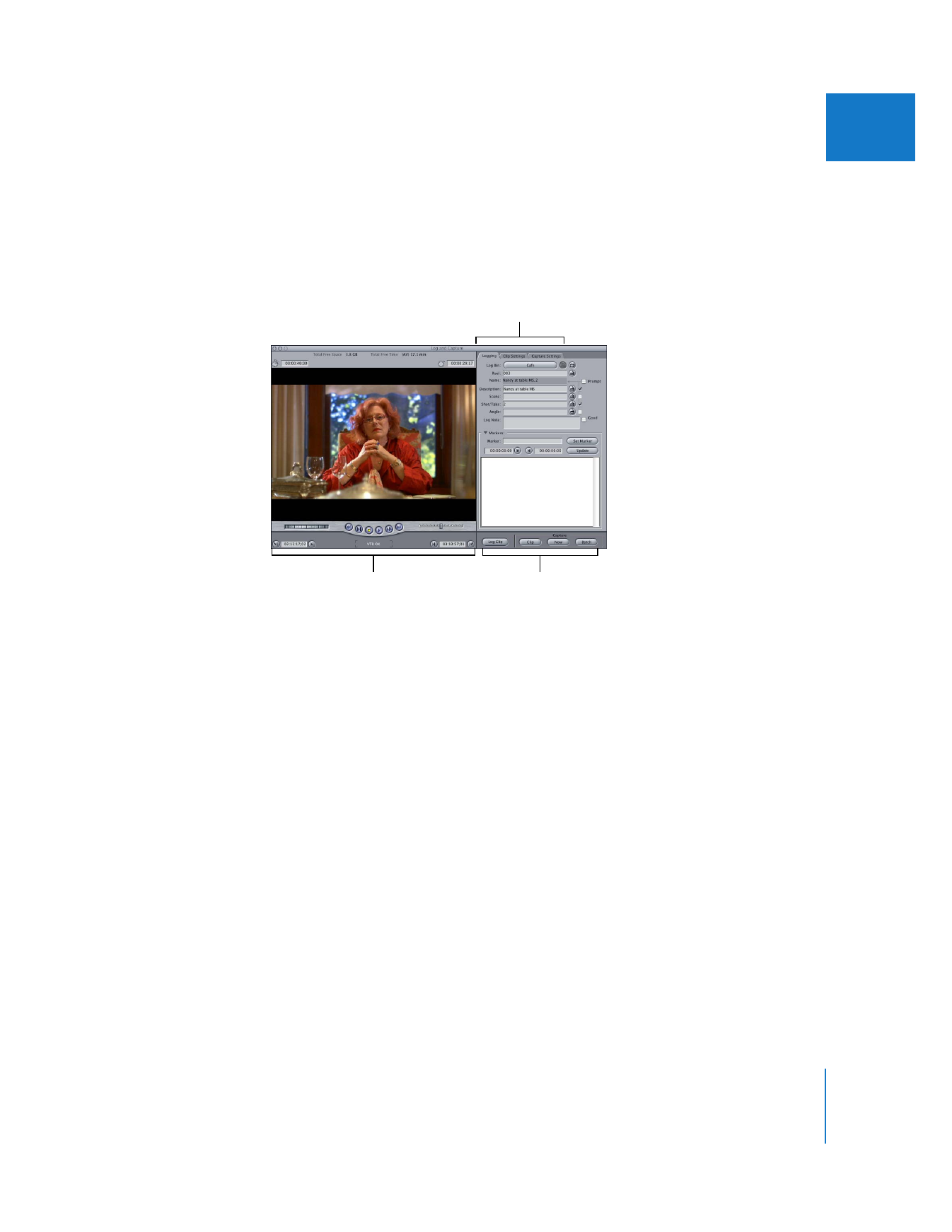
Ways to Log and Capture Footage in Final Cut Pro
In the early days of nonlinear editing systems, there was only one log and capture
workflow: log first to create clips, then batch capture selected clips’ media. This
workflow was necessary because hard disk capacity was limited, so editors had to be
selective about what they captured. Although this is still a good workflow for some
projects, it is no longer necessary to log your footage first and then batch capture.
Today, inexpensive, high-capacity hard disks allow editors to capture entire tapes and
log afterward. Once your footage is on the hard disk, you can review it more efficiently
than when it is on tape, which makes logging go faster.
In Final Cut Pro, most logging and capturing is done in the Log and Capture window,
but you can also use the Browser to add logging information to clips after you capture.
The most common logging and capturing workflows are described below.
Log your tapes, then batch capture using the Log and Capture window
This is the traditional method of logging and capturing. In this case, you watch your
footage by playing videotapes in a deck or camcorder connected to Final Cut Pro. You
can set In and Out points using the timecode information coming into Final Cut Pro,
and create clips that represent portions of your original videotape. After you finish
logging, you capture media for only the clips you think are necessary for your project.
Capturing the media files for many clips at once is called batch capturing.
 Logging: Use the Log Clip button in the Log and Capture window.
 Capturing: Batch capture selected clips that you think are useful for your project.
Log and capture clips one at a time, using the Log and Capture window
With this method, you log clips using a deck connected to Final Cut Pro, but you capture
each clip immediately after you log it. This is probably the most time-consuming of all the
methods because, unlike batch capturing, which is a semi-automated task, you oversee
the capture of each clip immediately after you log it.
Despite being more inefficient, this method is the most thorough and avoids any
pitfalls that may occur with automated batch capturing. If your tapes have a lot of
unexpected timecode breaks, or if you simply want to log and capture one or two clips
from a tape, you may prefer this method.
 Logging and Capturing: Use the Capture Clip button in the Log and Capture window
to log a clip to your project and capture its media file immediately afterward.

Chapter 15
Overview of Logging and Capturing
237
IV
Capture entire tapes, then create subclips and log in the Browser
This method is increasingly popular because hard disk space is no longer prohibitively
expensive. Instead of choosing selected footage to transfer to your hard disk, you
capture entire tapes. Once on disk, you can break the footage into smaller subclips, add
logging information in the Browser, and delete unnecessary media from your hard disk.
 Capturing: Capture entire tapes using the Capture Now button in the Log and
Capture window.
 Logging: In the Browser, break the clip representing each tape into smaller subclips
and add logging information.
 Media management: After you create subclips, you can break large media files into
smaller media files, one for each subclip, and delete any media you don’t need for
your project. The result is that you only have media files for clips you want to use.
There are several advantages to this method:
 Capturing entire tapes causes less wear on the tapes than traditional logging
because you only have to play them back once, straight through, to transfer media
files to the hard disk.
 Logging the media on the hard disk after capture is faster than tape-based logging
because you can access any frame instantly. You can also loop playback on a
particular shot to review it multiple times. On tape this would be much more
time-consuming.
Note: If you are using an uncompressed video format, the amount of hard disk space
required to capture entire tapes may still be too high, even with the cost of hard disk
space dropping rapidly. When you are editing with uncompressed video, it can still be
more cost-effective to log your tape first, then capture selected regions.
Log in another application, import a batch list, then batch capture clips
Some editors prefer to log their footage outside of Final Cut Pro, then import a batch
list of clips to automatically batch capture.
 Logging: In a spreadsheet or database application, enter clip name, reel name, Media
Start and End points, and other logging information, save it as a tab delimited text
file, then import this batch list into Final Cut Pro.
 Capturing: Batch capture selected clips that you think are useful for your project.

238
Part IV
Logging, Capturing, and Importing
Create clips directly in the Browser, then batch capture them
You can create clips directly in the Browser using the New Offline Clip command in the
File menu. You can enter pertinent logging information, and then batch capture the
clips. This approach is useful if you are only creating a few clips, or if you have a
handwritten list of clips that you logged somewhere else. Otherwise, creating and
importing a batch list may be faster.
 Logging: Create clips in the Browser, then add the reel number, Media Start and End
points, and any additional logging information to the various columns in the
Browser. To create new offline clips quickly, you can assign a shortcut key to the New
Offline Clip command (see “
Assigning Keyboard Shortcuts
” on page 148).
 Capturing: Batch capture the clips you created to make them online.
Log in the Log and Capture window without tapes in the camcorder or VTR
If you already have a handwritten list of clips and log notes, you can manually turn
them into clips in Final Cut Pro using the Log and Capture window. This works in the
same way as logging the tape, but no VTR is actually connected. This is an alternative to
creating offline clips directly in the Browser.
 Logging: Use the Log Clip button in the Log and Capture window.
 Capturing: Batch capture the clips you created to make them online.
Important:
Whenever you create clips from NTSC footage without a tape in your video
device, you risk entering the wrong type of timecode (drop frame instead of non-drop
frame or vice versa) because Final Cut Pro isn’t reading timecode directly from the tape
itself. If you are manually entering timecode in the Log and Capture window, and there is
no tape in the device, make sure that the Default Timecode pop-up menu in the device
control preset you are using is set to the proper timecode. (For more information, see
Volume IV, Chapter 26, “Device Control Settings and Presets.”) You can also Control-click
on the timecode field for the clip In or Out point in the Log and Capture window and
choose between drop frame or non-drop frame timecode.
Import Final Cut Pro XML created in another application, then batch capture clips
The Final Cut Pro XML Interchange Format can be used to represent entire projects,
including sequences, bins, and clips. Using any XML-compliant application, you can
create an entire project in the Final Cut Pro XML Interchange Format, import the XML
file, and then batch capture the clips. This is similar to importing a batch list, but with
XML you can create not only clips, but sequences, bins, effects, and so on.
 Logging: Import the XML file into Final Cut Pro.
 Capturing: Batch capture the clips you created to make them online.

Chapter 15
Overview of Logging and Capturing
239
IV